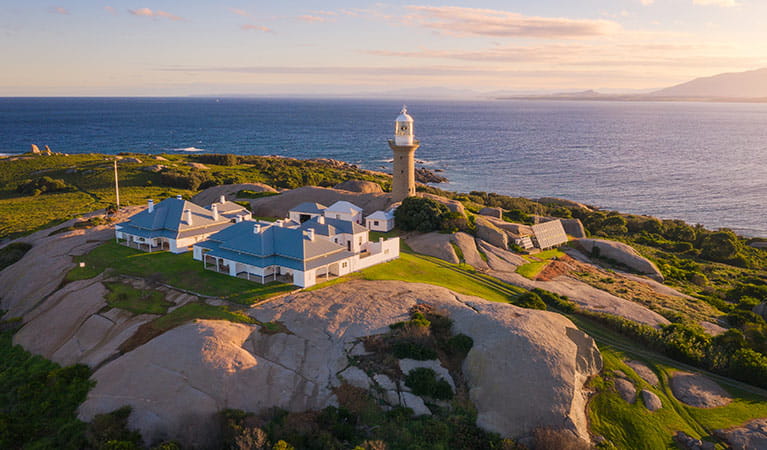Montague Island Head Lighthouse Keeper's Cottage
Barunguba Montague Island Nature Reserve
Overview
Enjoy a weekend getaway in the historic Montague Island Head Lighthouse Keeper’s Cottage and experience a unique adventure on Barunguba Montague Island.
| Accommodation type | Cottage |
|---|---|
| Bedrooms | 5 |
| Maximum guests | 10 |
| Facilities | Barbecue facilities, drinking water, showers, toilets, electric power, kitchen, plates and cutlery, pots and pans, bed linen, heating, tv, towels, rubbish bin |
| Bookings | Book online or call the National Parks Contact Centre on 1300 072 757. |
| Please note |
|
What could be more romantic than a night on an island in an historic lighthouse keeper’s cottage? Perfect for a special getaway or memorable occasion with friends and family, you’ll get a taste of island life on this unique wilderness sanctuary.
Built in 1881, the heritage cottage has been lovingly restored in the style of the era, except for one important feature. You’ll have access to all the modern conveniences to ensure your stay is comfortable and relaxed.
While on the island, take a walk on Barunguba Montague Island walking track or simply unwind on the wide verandah and watch for whales out at sea. Steal a moment of solitude in the secluded courtyards and reading rooms, or cook up an island feast in the fully-equipped kitchen.
Take a virtual tour of Montague Island Head Lighthouse Keeper's Cottage captured with Google Street View Trekker.
Map
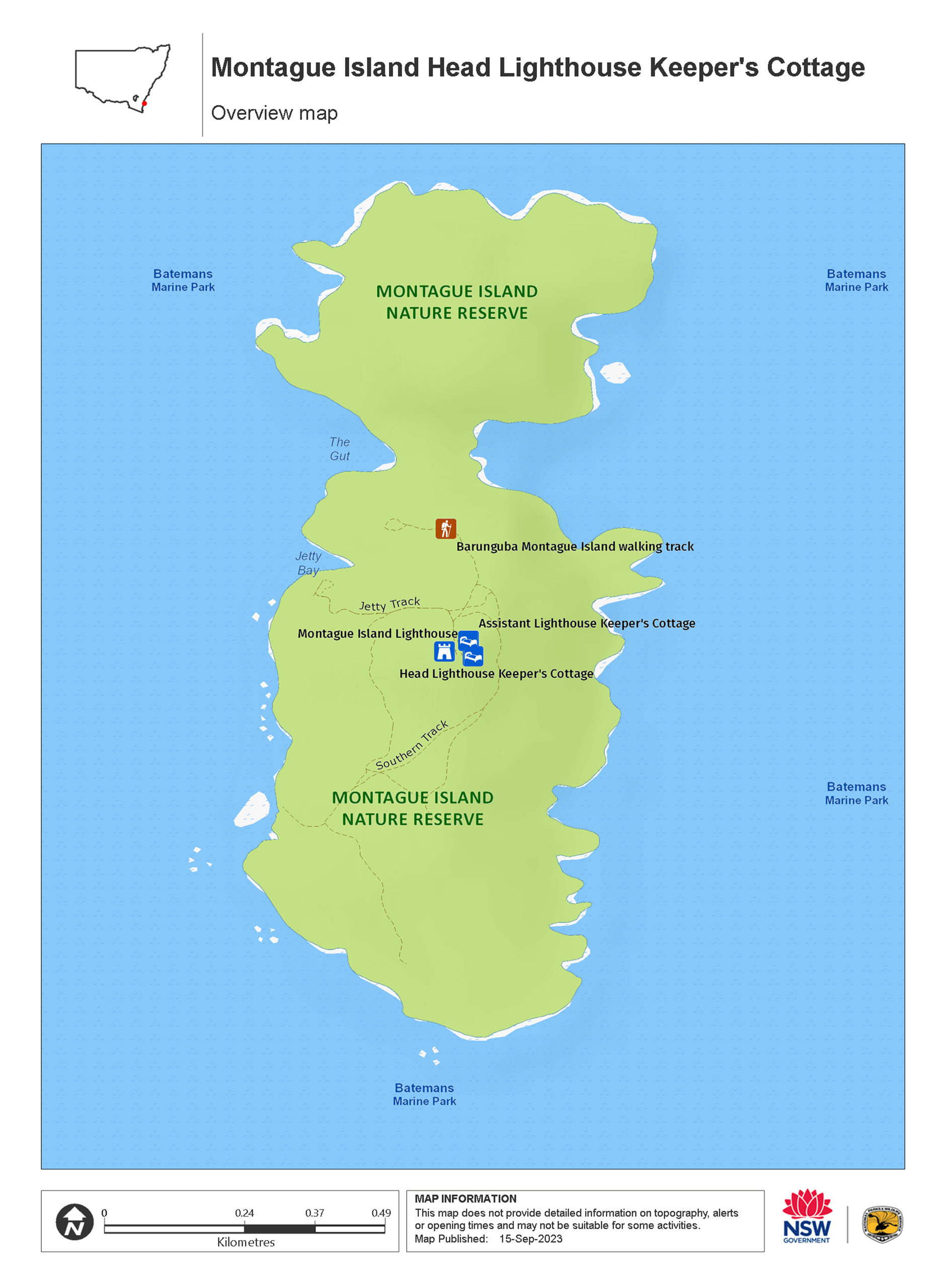
Map legend

Local alerts
For the latest updates on fires, closures and other alerts in this area, see https://www.nationalparks.nsw.gov.au/camping-and-accommodation/accommodation/montague-island-head-lighthouse-keepers-cottage/local-alerts
Bookings
- National Parks Contact Centre
- 7am to 7pm daily
- 1300 072 757 (13000 PARKS) for the cost of a local call within Australia excluding mobiles
- parks.info@environment.nsw.gov.au
Park info
- Narooma, NSW, 2546
- in Barunguba Montague Island Nature Reserve in the South Coast region
Barunguba Montague Island Nature Reserve is always open but may have to close at times due to poor weather or fire danger.
Please note: A minimum age of 5 years applies for all visitors. Barunguba Montague Island is only accessible via one of NSW National Parks and Wildlife contracted commercial vessel tour operators. Go to www.eurobodalla.com.au for details.
Visitor info
All the practical information you need to know about Montague Island Head Lighthouse Keeper's Cottage.
Getting there and parking
Get driving directions
The cottage is on Barunguba Montague Island and only accessible by NPWS-contracted commercial vessel tour operators. There is no private vessel access.
Boat transfers to the island are included in your accommodation package. More information on your transfer will be provided by the local NPWS office after booking. If you have not received additional information 1 week before your booking, please contact (02) 4476 0800 during office hours.
Transfers depart from Narooma wharf, Bluewater Drive, Narooma.
A minimum age of 5 years applies for all visitors to Barunguba Montague Island. Guests need to be able to independently climb the island’s jetty ladder and the steep hill that follows.
Weather restrictions
Barunguba Montague Island is an offshore island. It can be cut off from the mainland vessel access due to sea and swell conditions thus delaying access to and from the Island. In some instances delays may involve several days. Please arrive well-prepared.
Road quality
- Sealed roads
Vehicle access
- 2WD vehicles
Parking
Parking is available at Narooma wharf.
Best times to visit
There are lots of great things waiting for you on Montague Island Nature Reserve. Here are some of the highlights.
Spring
New Zealand and Australian fur seals are at their peak on the island during spring, making this the perfect time for some seal-spotting. To tempt you even more, humpback whales can often be spotted along the coastline, and pods of dolphins come to play among the boats too – book a guided tour that includes whale watching for the best chance to spot this special sea mammal in its own environment From October huge numbers of shearwaters begin to arrive and nest on the island through the summer.
Summer
Soak up the summer sun on a guided tour of Montague Island and provides some of the best weather for photographs.
Winter
From late winter the seal colony on the island starts to grow. It can get quite chilly in winter so pack warm clothes.
Weather, temperature and rainfall
Summer temperature
Average
15°C and 25°C
Highest recorded
38.7°C
Winter temperature
Average
4°C and 16°C
Lowest recorded
2.1°C
Rainfall
Wettest month
March
Driest month
July
The area’s highest recorded rainfall in one day
182mm
Facilities
- Bedding configuration: There are 5 bedrooms. 2 bedrooms have a queen-size bed and 3 bedrooms have 2 king single beds each.
- 2 showers, 2 toilets
- Wide verandahs.
- Private courtyard.
- Please leave the property clean and tidy with all kitchen items washed up and put away. Additional fees may be charged for any unreasonable cleaning required or missing/broken items.
Toilets
- Flush toilets
Barbecue facilities
- Gas/electric barbecues (free)
Drinking water
Showers
- Hot showers
Electric power
Montague Island uses solar power. Please avoid washing clothes during your stay, keep showering times to a minimum and turn off lights and appliances when you're not using them.
Kitchen
Fully-equipped kitchen with microwave, toaster, kettle, fridge and freezer, gas oven and gas cook top.
Plates and cutlery
Pots and pans
Bed linen
Heating
Gas heater.
TV
Towels
Rubbish bin
Maps and downloads
Accessibility
Disability access level - hard
Guests must be able to climb a ladder independently at the island jetty and walk up and down the Island’s steep and rocky terrain. Persons with mobility issues are asked to check when booking. Some activities require moderate fitness levels.
Prohibited
- Swimming directly from the island itself is not permitted.
- Amplified music is not permitted.
Camp fires and solid fuel burners
- Fires are not permitted, including in fireplaces.
Fishing
Fishing directly from the Island itself is not permitted.
Generators
Pets
Pets and domestic animals (other than certified assistance animals) are not permitted. Find out which regional parks allow dog walking and see the pets in parks policy for more information.
Smoking
NSW national parks are no smoking areas.
Learn more
Montague Island Head Lighthouse Keeper's Cottage is in Barunguba Montague Island Nature Reserve. Here are just some of the reasons why this park is special:
A sacred place
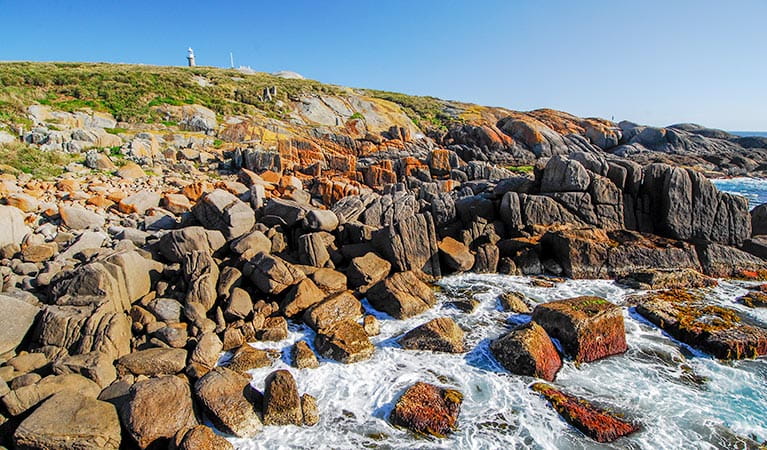
The Yuin people have had a long connection with Barunguba Montague Island, travelling to the island for traditional ceremonies and food, and using it as a men's teaching place. It would have been a dangerous trip - 9km each way by bark canoe. There are many Aboriginal artefacts and middens on the island. Barunguba is the eldest son of Gulaga (Mount Dromedary) and a brother to Najunuka (Little Dromedary). The older brother, Barunguba was allowed out to sea while Najunuka, the younger brother, had to stay close to his mother. To recognise its cultural significance to Yuin people, Barunguba was declared an Aboriginal Place under the National Parks and Wildlife Act 1974 in June 2018.
Colonial heritage
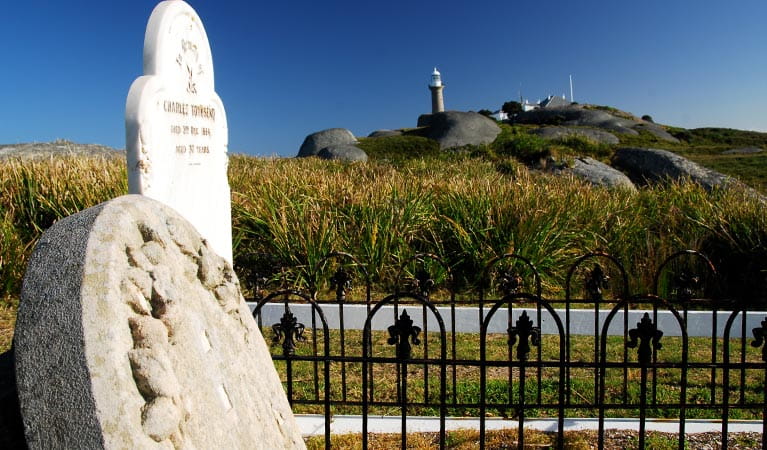
Get in touch with Australia's colonial history - Captain James Cook spotted the island from his tall ship in 1770 but assumed it was part of the mainland. It wasn't until 1790 that the island was officially identified by European Settlers as an island, and named 'Montagu' after the Earl of Halifax George Montagu Dunk, by the master of the convict ship Surprise. The island received visits from several shipwrecked sailors, and during the goldrush seabird eggs were collected from the island to sell to miners.
- Montague Island Lighthouse Montague Island Lighthouse on Barunguba Montague Island is the perfect place to get in touch with history while seeing dramatic views, amazing birds and marine wildlife.
A sanctuary for seabirds, seals and whales
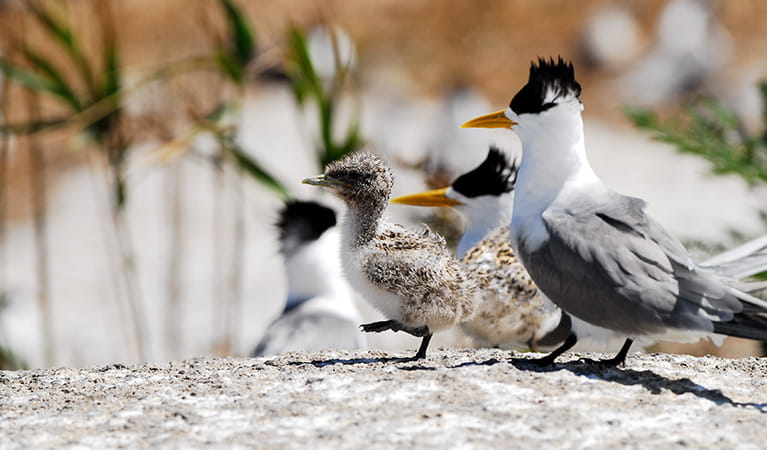
The protected waters of Barunguba Montague Island are a playground for hundreds of seals who make the island their home, all year round. Between September and November you can also see humpback and southern right whales pass the island on their annual migration south. Watch for blowholes and spectacular displays from the island or on a combined whale watching and island tour. With more than 90 bird species seen on the island, and 15 species breeding there, you’ll be reaching for your binoculars – and camera – at every turn. Up to 8,000 penguins live on the island at any one time. Between September and March they are joined by three species of shearwaters, which can produce more than 12,000 chicks per year, and their colonies seem to be growing!
- Barunguba Montague Island walking track This 1.5 km coastal walk around Barunguba Montague Island is short but challenging. It takes you past the historic lighthouse and precious penguin breeding boxes.
- Montague Island Lighthouse Montague Island Lighthouse on Barunguba Montague Island is the perfect place to get in touch with history while seeing dramatic views, amazing birds and marine wildlife.
Plants and animals protected in this park
Animals
-
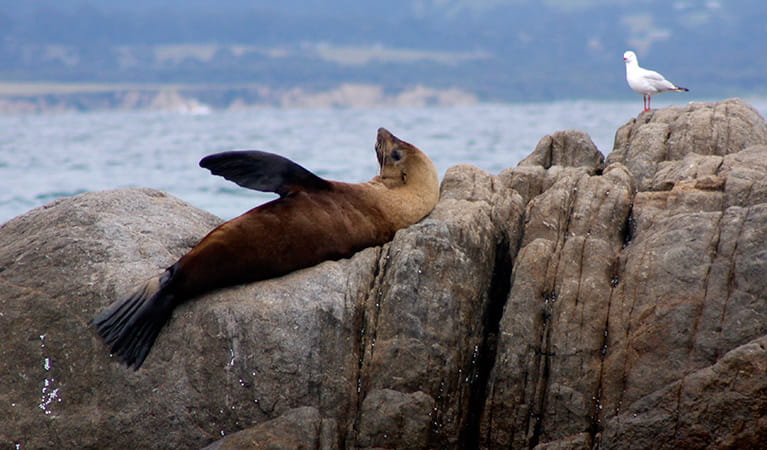
Australian fur seal (Arctocephalus pusillus doriferus)
The largest fur seal, Australian fur seals are found in isolated rocky outcrops and islands along the NSW coast. They come ashore to form breeding colonies and can often be seen at Barunguba Montague Island Nature Reserve.
-
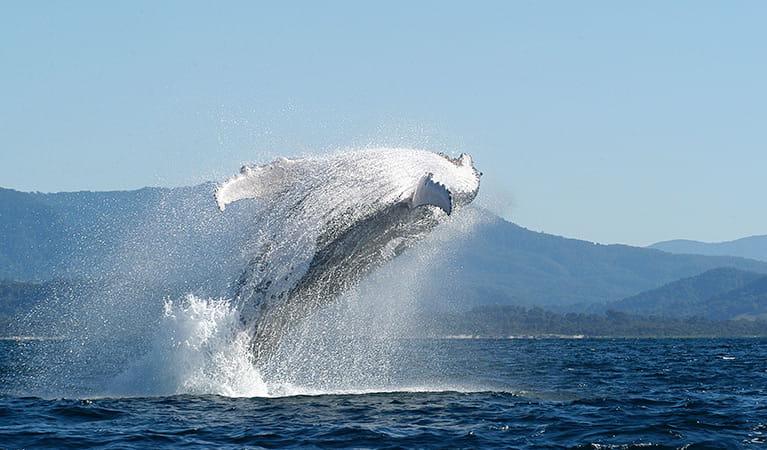
Humpback whale (Megaptera novaeangliae)
The humpback whale has the longest migratory path of any mammal, travelling over 5000km from its summer feeding grounds in Antarctica to its breeding grounds in the subtropics. Its playful antics, such as body-rolling, breaching and pectoral slapping, are a spectacular sight for whale watchers in NSW national parks.
-

White-bellied sea eagle (Haliaeetus leucogaster)
White-bellied sea eagles can be easily identified by their white tail and dark grey wings. These raptors are often spotted cruising the coastal breezes throughout Australia, and make for some scenic bird watching. Powerful Australian birds of prey, they are known to mate for life, and return each year to the same nest to breed.

